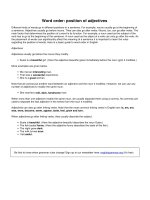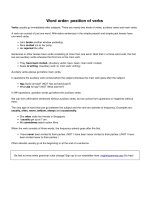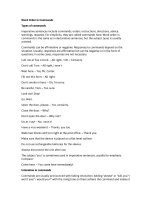Word order
Bạn đang xem bản rút gọn của tài liệu. Xem và tải ngay bản đầy đủ của tài liệu tại đây (148.81 KB, 16 trang )
Unit 29 (Unidad 29)
Word order (El orden de las palabras)
(It is recommended that, to take full advantage of this unit on word order, it be studied after most of
the other units, since it suggests a degree of sophistication which can only be acquired from some
previous penetration into the language.)
Level 1
1.1 Subject + verb + object (Sujeto + verbo + objeto/complemento)
1.2 Verb + subject (Verbo + sujeto)
1.3 Bien and mal with verbs (Bien y mal con verbos)
1.4 Adjectives with nouns (Adjetivos con nombres)
1.5 Pronouns + verbs (Pronombres y verbos)
1.6 Numbers + Otros/as (N
´
umeros + otros/as)
1.7 Some flexibility with numbers (Alguna flexibilidad con n
´
umeros)
1.8 Dates (Fechas)
1.1 Subject + verb + object
Essentially, Spanish word order is like English word order in that the subject precedes
the verb that precedes the object: Juan lee el libro – John reads the book.However, the
flexibility of the Spanish language frequently means that this order is not respected. It
can be affected by a whole range of considerations such as the written word as opposed
to the spoken word, the intention of an author in stressing an idea, length of sentences,
questions of balance, the need to avoid clumsiness, short words as opposed to long words,
use of punctuation, repetition – the list is endless.
Thefirst feature to notice in Spanish word order is that the verb does not necessarily
follow the subject. Compare the following two sentences:
El amigo se va The friend goes away
Se va el amigo The friend goes away
In these two sentences, the emphasis switches from El amigo in the first to Se va in
the second since both of these sets of words appear at the beginning of their respective
sentences. Much of the complexity and variability of the Spanish sentence flows from
this simple but important inversion.
269
ASTUDENT GRAMMAR OF SPANISH
1.2 Verb + subject
Conditions when the subject comes after the verb:
i Where the subject is much longer than the verb or verb phrase, and often when the
verb is reflexive. This is designed to create a sense of balance:
Durante mucho tiempo se oye un ruido ensordecedor Yo u can hear a deafening noise over a long
period of time
Del lat´ın vienen el espa˜nol, el franc´es, el italiano y el
portugu´es
Spanish, French, Italian and Portuguese
come from Latin
ii Where the verb does not take a direct object. These verbs include:
doler (to hurt), faltar (to be lacking), gustar (to please = to like), quedar (to remain), sobrar (to
be over / in excess)
Me duele la cabeza My head hurts (i.e. I have a headache)
Me duelen los dientes I’ve got toothache (i.e. more than one)
Faltan dos tenedores aqu´ı We need two more forks here
Me gusta este pan I like this bread
Quedan doscientos metros hasta la cumbre There are another two hundred meters to
the top
Porlovisto sobran camas Apparently there are beds left over
iii When a plural subject is used without an article: this often occurs when the verb is
reflexive or intransitive:
En el mercado se venden peras Pears are sold in the market
Se ponen las c´ascaras en el bote (M)/cubo The peelings are put in the can
Corren conejos por todas partes Rabbits are running everywhere
Llegan ni˜nos de muy lejos Children come from a long way away
1.3 Bien and mal with verbs
Whereas, in English, the adverb can be separated very easily from the verb, such is not
the case in Spanish, unless the adverb or adverbial phrase is a long one. Again, it is a
question of balance.
Compare the two sentences in each of the following pairs of sentences:
Habla bien el chino She speaks Chinese well
Habla el chino estupendamente bien She speaks Chinese marvelously well
Escribe mal el ingl´es He writes English badly
Escribe el ingl´es incre´ıblemente mal He writes English incredibly badly
In the first sentence, bien immediately follows the verb, but in the second it follows the
object since, accompanied by another adverb, it would be cumbersome and sound odd
if it preceded the object. The same comments apply to the second set of sentences with
mal.
270
29 Word order
1.4 Adjectives with nouns
(See also unit 21 on adjectives, levels 1 and 2)
i An adjective following a noun usually has a “distinctive” overtone, a nuance which is
often conveyed by contrastive stress:
“¿C´omo es tu casa?” “What’s your house like?”
“Es una casa peque˜na” “It’s a small house”
Peque
˜
na is emphasized with rising intonation at the end of the sentence.
However, in the sentence
Viv´ıa en una peque˜na casa cerca de la catedral He lived in a small house near the cathedral
peque
˜
na may be used before or after the noun with little difference of meaning or
stress.
ii Note the difference between the two following sentences:
Las hojas secas caen Thedry leaves fall
Las secas hojas caen Thedry leaves fall
Here, it is a case of some of the dry leaves, as in the first case, or of all the dry leaves,
as in the second case. The distinctive feature of the leaves in the first sentence is that
some of them are dry. Secas is invested with greater importance in the first sentence and
therefore comes after hojas.
iii But, the difference in adjectives before or after the noun is by no means clear cut.
Largo,for instance, precedes the noun in the sentence below:
Damos un largo paseo por el campo We go for a long walk in the country
Here, largo would sound odd after the noun. However, if muy were introduced to
qualify largo, largo before or after the noun would be acceptable:
Damos un muy largo paseo / un paseo muy largo por el campo
iv There are some adjectives in Spanish which differ in meaning according to whether
they precede or follow the noun. As a rule, the adjective after the noun receives
more emphasis than were it before the noun. Here is a short list:
antiguo costumbres antiguas old customs
un antiguo presidente aformer president
cierto indicios ciertos sure / definite signs
ciertas personas certain people
diferente libros diferentes different books
diferentes libros several books
distinto ideas distintas distinct ideas
distintas ideas various ideas
grande una casa grande a big house
un gran escritor agreat writer
ligero una mesa ligera a light table
de ligera importancia of slight importance
271
ASTUDENT GRAMMAR OF SPANISH
nuevo una canci´on nueva a brand new song
hemos comprado una nueva casa We’ve bought a new / another house
pobre un barrio pobre a poor district
¡Pobre mujer! Poor woman!
´unico su hija ´unica their only daughter
la ´unica soluci´on the only solution
v Some adjectives are always distinctive and rarely, if ever, precede the noun. Such
adjectives typically denote nationality, membership of a political or religious
ideology, color, etc.
Es de nacionalidad mexicana He’s of Mexican nationality
un carro (M)/coche franc´es aFrench car
el partido socialista the socialist party
la religi´on musulmana the Muslim religion
Me gusta el vino tinto / blanco I like red/white wine
una casa amarilla ayellow house
un estudio literario a literary study
una servilleta in´util a useless napkin/serviette
´acido sulf´urico sulphuric acid
1.5 Pronouns + verbs
Spanish pronouns precede the verb, except in the case of the imperative. For a full
treatment of the topic see the units on pronouns (unit 17) and the imperative (unit 11).
Examples
Te doy el libro I give you the book
Te lo doy Igiveittoyou
Se lo doy I give it to her/him/you
D´amelo Give ittome
1.6 Numbers + otros/as
Otros/as precedes the number, witness the examples:
otros cuatro hombres another four men
otras cinco mujeres another five women
otros tantos ´arboles just as many other trees
otras pocas chicas a few other girls
1.7 Some flexibility with numbers
There is some flexibility with numerals when used with primero and
´
ultimo.
los dos primeros/´ultimos a˜nos the first/last two years
los primeros / ´ultimos dos a˜nos the first/last two years
272
29 Word order
1.8 Dates
Theorder of the definite article in dates:
Hoy es el s´abado 5 (cinco) de enero Today is Saturday the fifth of January
Llegan el martes 4 (cuatro) de abril They arrive on Tuesday the fourth of April
Exercises
Level 1
i Put the following words in their correct order. There may be more than one order in
many cases.
Example
cansado se chico temprano el acuesta > El chico cansado se acuesta temprano / Se
acuesta temprano el chico cansado
a tranquilidad m´edico recomienda le el
b bicicleta en me andar gusta
c dos quedan vacaciones las para semanas me
d tela metros tres sobran de
e idiomas pocos dos bien hablan
f canci´on chica la la mal canta
g de tiempo corre el prisa
h r´ıo carretera el la corre a junto
i cambios partido los el opone a se conservador
j M´exico brasile˜na queda familia se en la
k salita despacho el la barrer por queda y
l ´arboles casas tapan nos vista las los y la verdes negras
m monta˜nas las altas las alcanzar podemos cumbres de
n doscientos da otros euros me
o premios diez ganaron primeras chicas las
p octubre llegamos dos el de s´abado
ii Actividad en com ´un (the information for these last exercises is in Spanish)
Objetivo – Estudiar el orden de las palabras
M
´
etodo –Unmiembro de la clase, con ayuda del profesor, escribe en el pizarr´on (M)
/lapizarra, diez frases pero con las palabras mezcladas. Las frases no son largas, con un
m´aximo de seis palabras. Dos equipos, ya formados, adivinan (guess)elorden correcto de
las frases. El equipo que alcance primero seis frases correctas gana el concurso.
Ejemplos
la duele mano me > Me duele la mano
me d´olares cien quedan >Me quedan cien d´olares
portugu´es mal muy escribe el > Escribe muy mal el portugu´es
Level 2
2.1 Adjective + (i.e. that precedes) noun (Adjetivo + [que se antepone al ] nombre)
2.2 Two adjectives + noun (Dos adjetivos + nombre)
273
ASTUDENT GRAMMAR OF SPANISH
2.3 Verb + subject (Verbo + sujeto)
2.4 Meaning of adjective according to position (Sentido del adjetivo seg
´
un su
posici
´
on / ubicaci
´
on [M])
2.5 Changing position of words with little difference in meaning (Posici
´
on /
Ubicaci
´
on [M] cambiante de palabras sin diferencia de sentido)
2.6 Word order with the reflexive se (Orden de palabras con se)
2.1 Adjective + (i.e. that precedes) noun
i Other factors favoring the adjective preceding the noun
When adjective and noun make a familiar or set phrase:
los altos Alpes the high Alps
un ligero aumento en el coste de la vida a slight rise in the cost of living
el presunto culpable the alleged guilty person
las peque˜nas y medianas empresas small and medium-sized companies
ii When the adjective is an expected attribute:
un lamentable accidente a lamentable accident
con enormes dificultades with enormous difficulty
2.2 Two adjectives + noun
When there is more than one adjective, the most distinctive one is placed furthest away
from the noun. This, again, conforms to the notion of emphasis placed at the end of the
sentence:
la pol´ıtica contempor´anea mexicana contemporary Mexican politics
la situaci´on militar africana the African military situation
la literatura argentina actual present Argentinian literature
la opini´on pol´ıtica popular popular political opinion
2.3 Verb + subject
The subject frequently follows the verb in the following circumstances
i When a preposition such as a or de begins the sentence:
Al hombre le vino la idea de salir enseguida The man had the idea of going out
immediately
A todos los chicos se les ocurri´o jugar (al) f´utbol All the boys had the thought of playing
football
Aminomegusta la m´usica popular I don’t like popular music
De su silencio se deduce que no vendr´a We can deduce from his silence that he’s
not coming
274









